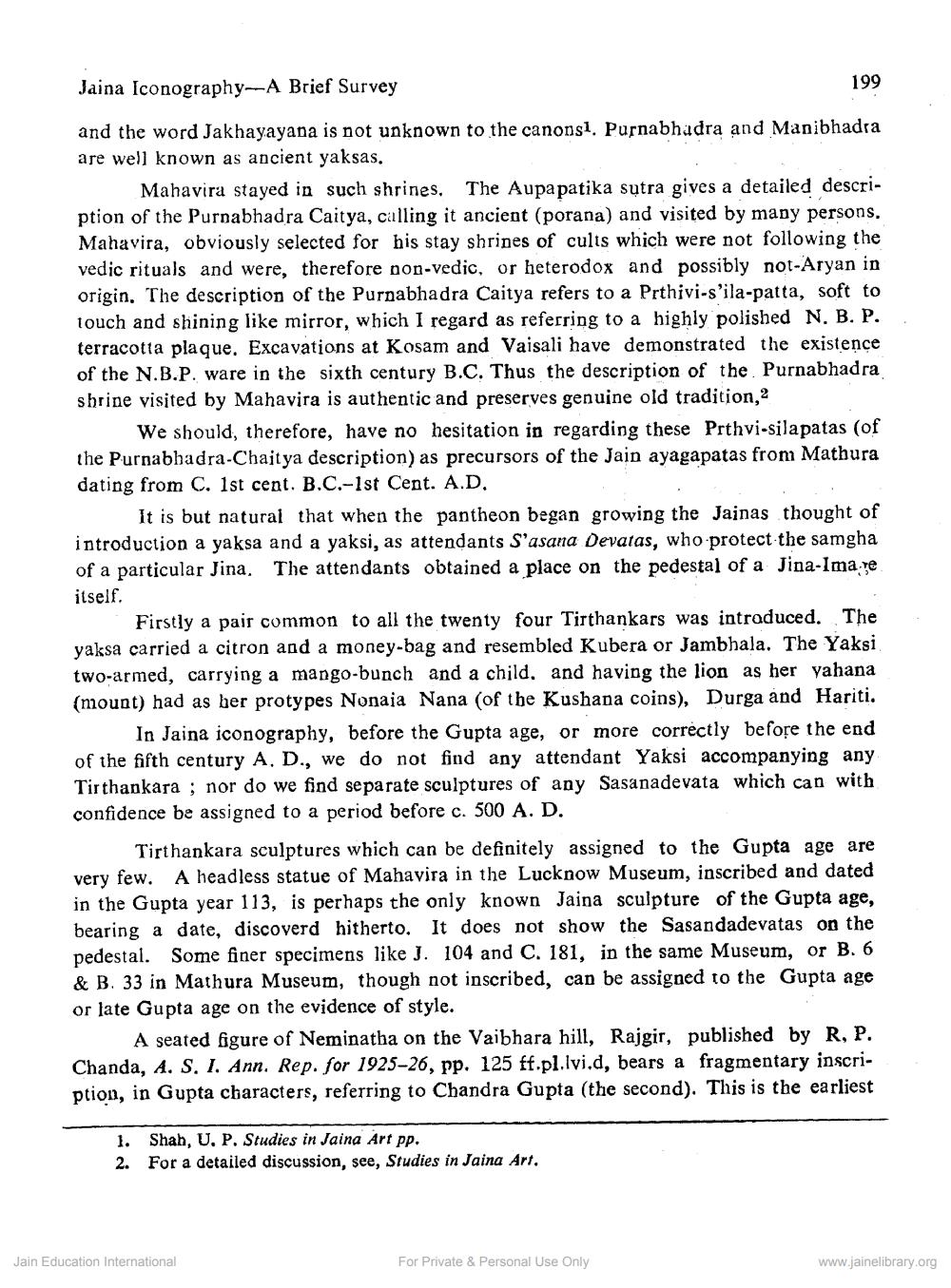________________
Jaina Iconography-A Brief Survey
199
and the word Jakhayayana is not unknown to the canonsl. Purnabhadra and Manibhadra are well known as ancient yaksas.
Mahavira stayed in such shrines. The Aupa patika sutra gives a detailed description of the Purnabhadra Caitya, calling it ancient (porana) and visited by many persons. Mahavira, obviously selected for his stay shrines of cults which were not following the vedic rituals and were, therefore non-vedic, or heterodox and possibly not-Aryan in origin. The description of the Purnabhadra Caitya refers to a Prthivi-s'ila-patta, soft to touch and shining like mirror, which I regard as referring to a highly polished N. B. P. terracotta plaque. Excavations at Kosam and Vaisali have demonstrated the existence of the N.B.P. ware in the sixth century B.C. Thus the description of the Purnabhadra shrine visited by Mahavira is authentic and preserves genuine old tradition, 2
We should, therefore, have no hesitation in regarding these Prthvi-silapatas (of the Purnabhadra-Chaitya description) as precursors of the Jain ayagapatas from Mathura dating from C. 1st cent. B.C.-1st Cent. A.D.
It is but natural that when the pantheon began growing the Jainas thought of introduction a yaksa and a yaksi, as attendants S'asana Devatas, who protect the samgha of a particular Jina. The attendants obtained a place on the pedestal of a Jina-Ima ye itself.
Firstly a pair common to all the twenty four Tirthankars was introduced. The yaksa carried a citron and a money-bag and resembled Kubera or Jambhala. The Yaksi two-armed, carrying a mango-bunch and a child, and having the lion as her yahana (mount) had as her protypes Nonaja Nana (of the Kushana coins), Durga and Hariti.
In Jaina iconography, before the Gupta age, or more correctly before the end of the fifth century A. D., we do not find any attendant Yaksi accompanying any Tirthankara ; nor do we find separate sculptures of any Sasanadevata which can with confidence be assigned to a period before c. 500 A. D.
Tirthankara sculptures which can be definitely assigned to the Gupta age are very few. A headless statue of Mahavira in the Lucknow Museum, inscribed and dated in the Gupta year 113, is perhaps the only known Jaina sculpture of the Gupta age, bearing a date, discoverd hitherto. It does not show the Sasandadevatas on the pedestal. Some finer specimens like J. 104 and C. 181, in the same Museum, or B. 6 & B. 33 in Mathura Museum, though not inscribed, can be assigned to the Gupta age or late Gupta age on the evidence of style.
A seated figure of Neminatha on the Vaibhara hill, Rajgir, published by R, P. Chanda, A. S. I. Ann. Rep. for 1925-26, pp. 125 ff.pl.lvi.d, bears a fragmentary inscription, in Gupta characters, referring to Chandra Gupta (the second). This is the earliest
1. 2.
Shah, U, P. Studies in Jaina Art pp. For a detailed discussion, see, Studies in Jaina Art,
Jain Education International
For Private & Personal Use Only
www.jainelibrary.org




